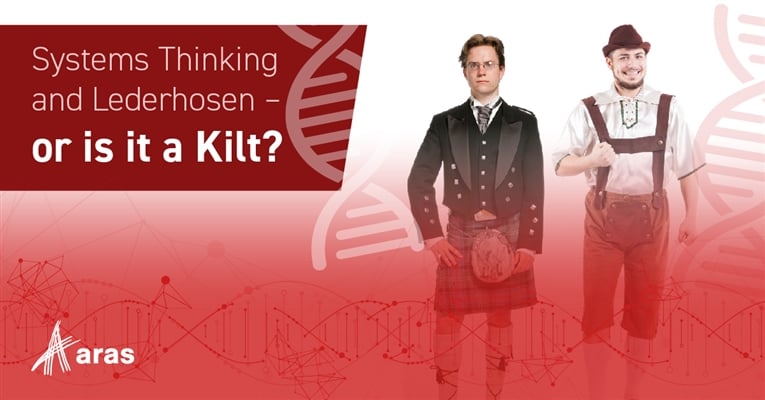Remember the Ancestry.com commercial where a fellow wearing German lederhosen switches to a Scottish kilt after taking a DNA test? While his family-centric Systems Thinking clearly was connecting the wrong genealogical dots—that’s the last thing you want to happen when using Systems Thinking to connect your digital thread dots. OK, let me explain the analogy, because it happens to be critical to your ability to becoming more operationally efficient through digitalization.
Digital thread is a critical part of managing product complexity because it enables traceability between all digital elements and artifacts that define the intent and the design of a product. As far as the digital engineering is concerned, this includes traceability between requirements, systems architecture, variability, simulation, detailed designs, collaboration, and validation and verification. This applies to every design representation and every lifecycle state. And of course, it should also expose the history of how decisions were made, what was considered, what was rejected, what was accepted, and why—design intent and design data. Digital thread, in other words, is your digital DNA that also captures your product strategy.

Fig 1. The ultimate scope of a digital thread
But digital thread DNA is different from human DNA since it is not there a priori but must be modeled by your enterprise to reflect the uniqueness of your business. I stress the word uniqueness because determining that aspect of your digital thread takes what we call Systems Thinking—determining what are the essential items, structures, and relationships in your business context. And that, in turn, does not come out-of-the-box (OOTB) in a preconfigured fashion. If an OOTB model of a digital thread was sufficient, then it would not offer you any strategic advantage over your competition since everybody would have an identical one. To put it another way, if digital thread was like genealogy, then you would look for the commonality in DNA. But it is not—it is part of managing product complexities and differentiation that should accentuate your competitive advantage. Otherwise, why bother?
Which brings up the subject of the flexibility of a PLM platform. Only some platforms, like Aras’ Industrial Low-Code Platform, come with a pre-configured digital thread OOTB to help you not only start the process, but also allows you to extend that definition over time by modeling new items, new structures, and new semantically rich relationships. That flexibility is critical to the point about business advantage that I’ve already made, but it is also critical to the ability to embrace, over time, emerging technologies such as IoT, AI, generative designs, or Machine Learning. Model-Based Systems Engineering (MBSE) is a perfect example of the need to continuously evolve your digital thread. Who would have thought just a few years ago that systems modeling tools like Cameo, Rhapsody, GENESYS, Enterprise Architect, or Capella would play such a vital role in managing today’s design complexities for just about everybody? Or that Simulation Process and Data Management (SPDM) would so quickly be evolving into a pervasive capability that must be available at every representation and every lifecycle state of a design? Or that requirements would be so quickly evolving from text-based content to parametrically driven constructs? That is the real challenge for the industry—while focusing on the immediate needs of digitalization (e.g., MBSE), simultaneously adapting infrastructure and PLM platforms that allow for continually evolving digital thread in the years to come, and ultimately avoiding being locked into a fixed OOTB structure defined a priori for you by the vendor. Oh, BTW, that includes making sure that any potential shift in PLM platform strategy to the cloud does not come at the cost of decreased functionality or flexibility by moving to the cloud.

Fig 2. Your digital thread DNA is your business advantage
In the end, the last place you want to find yourself is selling leather kilts in Scotland or plaid lederhosen in Germany due to a poorly modeled or inflexible digital thread. Bad idea! It’s all about leveraging Systems Thinking and PLM platform flexibility in the context of your product strategy. Without which you risk missing or yielding your share of your target market.
For more information on Systems Thinking, visit our website.

